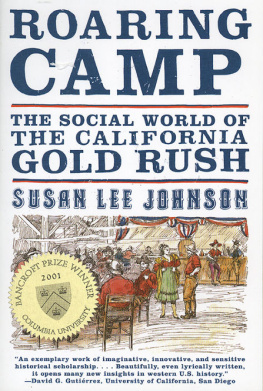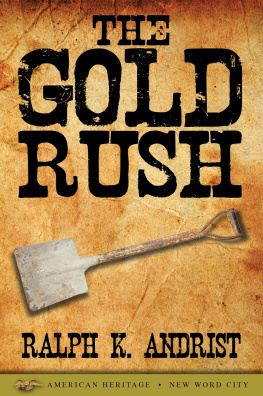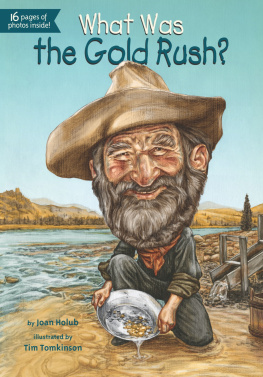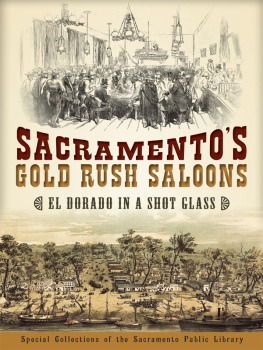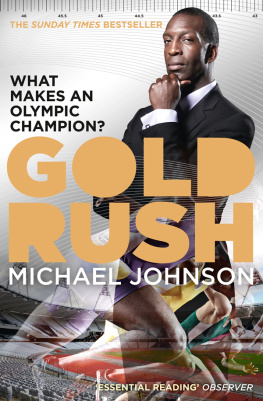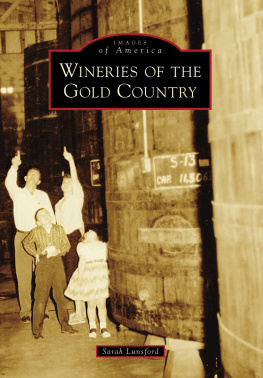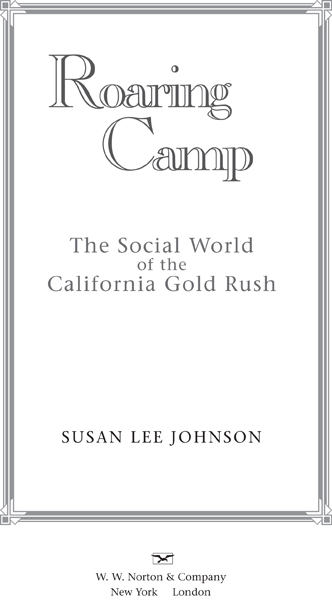
For my father, Bud,
in memory of rivers;
For my mother, Jan,
in honor of seasons;
To my lover, Camille,
for the wisdom of arroyos.
It takes a long time to remember, it takes generations,
sometimes nations, to make a story.
Betty Louise Bell, Faces in the Moon
Contents
Map: Gold Rush California
Map: Californias Southern Mines
Until about the twentieth of September, the Indians had worked constantly around us. All the companies let them go freely where it seemed good to them, even in our ditches, to gather the paydirt in their pans, carry it on their heads and go wash it at the river. The women especially did this work; however, I have never seen an Indian woman cede to her husband the gold she gathered, which made me suppose that each one worked for herself.
Jean-Nicolas Perlot, Gold Seeker: Adventures of
a Belgian Argonaut during the Gold Rush Years
F OR MANY OF US, thoughts of the California Gold Rush do not evoke scenes like the one described in this epigraph, in which French and Belgian men mine for gold side by side with Miwok Indian women. Since we do not envision such scenes, we also cannot ask why European miners might think of themselves as letting native peoples pan for gold in California, and why a Belgian man might conclude that Miwok women worked only for themselves. Our failure to consider such scenes and ask such questions is part of a larger problem of collective memory. After the decline of Californias surface diggings in the 1850s, the Gold Rush increasingly came to be remembered as the historical property of Anglo Americans, especially Anglo American men, and came to be associated in everyday language with facile notions of fast fortune. It is the task of this book both to interrogate and to dismantle the stories white Americans have told themselves about the California Gold Rush, and to offer instead a pastiche of tales that will help us think as complexly and critically about the conquest of history as we have begun to think about the history of conquest.
To accomplish this task, I focus on the region that Gold Rush participants called the Southern Mines, or that area in the Sierra Nevada foothills drained by the San Joaquin River. The Southern Mines are particularly illuminating for my purposes because the regions population was more diverse than that of the Northern Mines (the foothill area drained by the lower Sacramento River). Mexicans, Chileans, French, and Chinese were prominent in the southern region, and Miwok Indians maintained a strong presence there. African Americans, both enslaved and free, also worked alongside Anglo Americans in the Southern Mines. Indeed, the Gold Rush was not only among the most demographically male events in human history, it alsoparticularly as it transpired in the Southern Mineswas among the most multiracial, multiethnic, multinational events that had yet occurred within the boundaries of the United States. In addition, unlike the Northern Mines, the Southern Mines failed to follow what historians have described as the typical trajectory of industrialization for western mining, in which placer (surface, individualized) techniques gave way in an orderly fashion to hardrock (underground, industrialized) mining. Not surprisingly, then, the Southern Mines have constituted the area least studied by historians, though diggings in the far northwestern corner of California share with the southern region a history of neglect.
The stories I tell about the Gold Rush have in common a concern with relations of difference and domination, relations frequently defined along lines of gender and race or ethnicity or nationality, and often made manifest in economic terms. In this, I have placed Anglo American men as squarely within social constructs of gender and race or ethnicity or nationality as, for example, women (of all races, ethnicities, and nationalities) and emigrants, white ethnics, and peoples of color (both women and men). And I have identified the pursuit of dominance on the part of some white American men in the diggings as a first step in the long discursive process by which whole pieces of Californias Gold Rush past fell by the wayside of history. Those pieces could not be reconfigured in memory until the wholesale transformation of the subject of history began over three decades ago, with the painstaking work of scholars of class, race, sexuality, and gender. In the end, it is the social movements that inspired such scholarship that have most deeply influenced my thinking in this book.
The avid reader of mining histories may hear echoed in the title of this work the name of a fine book about mining in British Columbia, Jeremy Mouats Roaring Days: Rosslands Mines and the History of British Columbia (1995). I dont mean to be a claim jumper. My title actually comes from the famous Bret Harte story The Luck of Roaring Camp, which I analyze in the epilogue.
Earlier, abbreviated versions of two chapters of this book have appeared in print elsewhere: Domestic Life in the Diggings: The Southern Mines in the California Gold Rush, in Over the Edge: Remapping the American West, ed. Valerie J. Matsumoto and Blake Allmendinger (Berkeley: Univ. of California Press, 1999), and Bulls, Bears, and Dancing Boys: Race, Gender, and Leisure in the California Gold Rush, Radical History Review 60 (Fall 1994).
Beyond my overriding debt to activists for race, gender, sexual, and economic justicewho first won my admiration when I was growing up during the 1960s in Madison, WisconsinI am obliged to a good number of individuals and institutions. This book began as a dissertation, for which I received support from the Mrs. Giles Whiting Foundation (Whiting Fellowship in the Humanities); the Woodrow Wilson National Fellowship Foundation (Charlotte W. Newcombe Dissertation Fellowship); the Huntington Library (Research Fellowship); and Yale University (John F. Enders Fellowship). At Yale, Florence Thomas cheerfully charted my progress through the graduate program. At the University of Michigan, both the Womens Studies Program and the Department of History granted me funds for last-minute research assistance as I was finishing the dissertation. Staff in both units, particularly Judy Mackey and Janet Fisk, helped me manage these funds and navigate a new academic environment. They and their coworkers deserve raises, roses, and utmost respect.
The journey from dissertation to book was long and full of detours, as matters of love and death kept me packing, unpacking, and repacking my things in an effort to live in accordance with what mattered most to me. In the meantime, I was fortunate to receive extraordinary support from the University of Michigan in the form of a Faculty Grant and Fellowship as well as a Michigan Faculty Fellowship at the Institute for the Humanities. I am most grateful not only for this material assistance but for the encouragement both fellowships offered me at a time when family matters weighed on my heart. I also have continued to benefit from the generosity of the Huntington Library, which gave me a National Endowment for the Humanities Fellowship that allowed me an entire academic year at that institution. It was during that year that I produced most of this books final two chapters as well as the epilogue. When I was in the final hours of finishing the book, I received a Deans Summer Research Fellowship at the University of Colorado at Boulder, which allowed me to return to California to gather illustrations. Thanks to Dianne Johnson for helping me manage those funds.
Archivists, librarians, local historians, and other kind folks made sure I had access to the necessary materials for this study. George Miles at the Beinecke Library walked me through the closed stacks and explained the intricacies of cataloging there well before this project took shape as a dissertation, and then continued to be of tremendous assistance in the years that followed. Waverly Lowell gave me tips on California archival resources generally. Nicole Bouch helped me at the Bancroft Library, and, when I went back there to search for illustrations, Jack von Euw made sure I found what I needed in record time. During an early research trip to the Bancroft, I was fortunate to find a seat next to the Berkeley graduate student Michael Gonzlez, now of the University of San Diego. Michael not only pointed me toward source materials but also helped me survive the 1989 earthquake. Another Berkeley graduate student, Judy Yung, now of the University of California, Santa Cruz, assisted me in all matters related to Chinese Gold Rush experiences, for which I will always be indebted. I am also grateful to Sally McCoy, who took me into her El Cerrito home while I was working at the Bancroft. The staff at the California State Library in Sacramento and the Holt-Atherton Center for Western Studies at the University of the Pacific at Stockton, especially Daryl Morrison, also gave me much aid.
Next page
